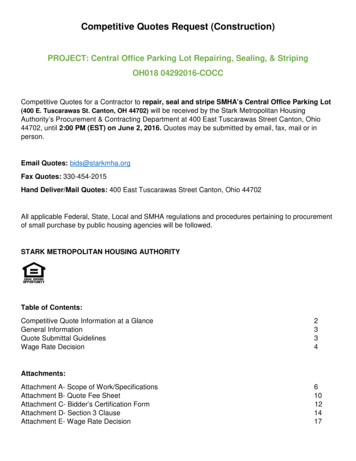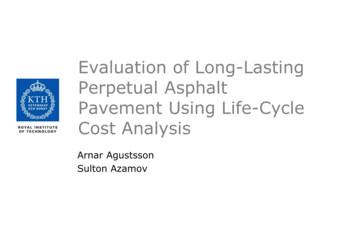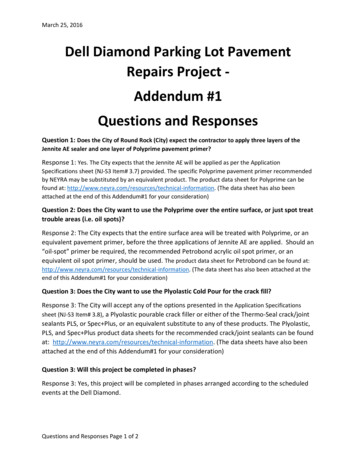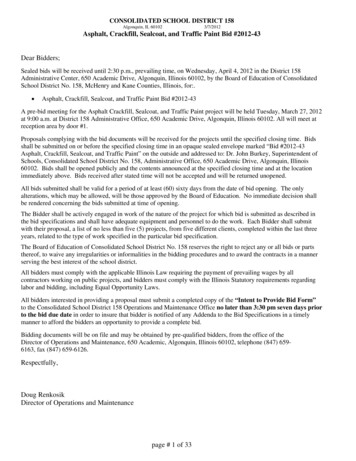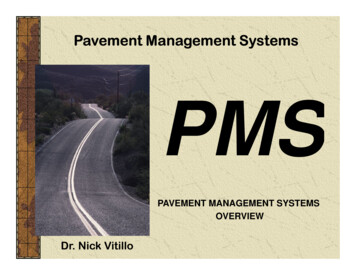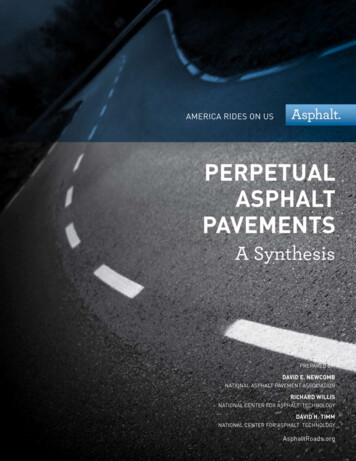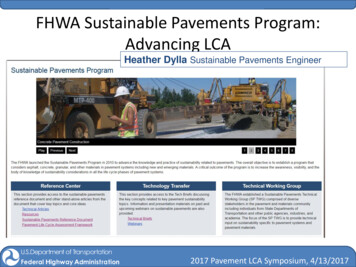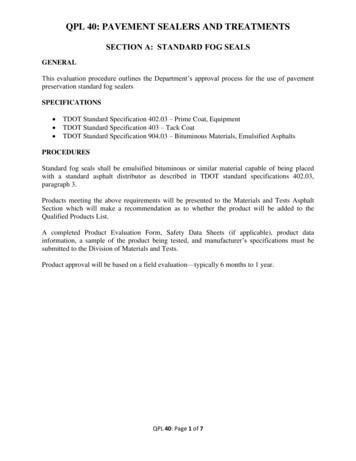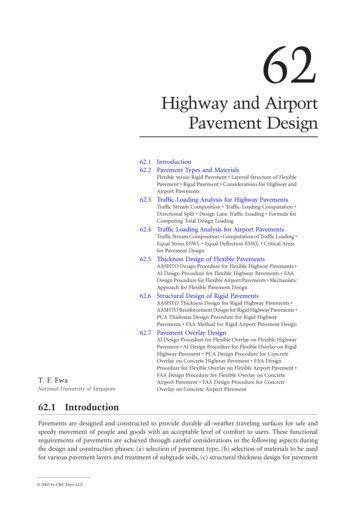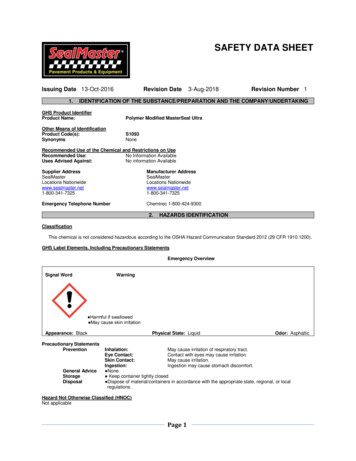
Transcription
SAFETY DATA SHEETIssuing Date 13-Oct-20161.Revision Date3-Aug-2018Revision Number 1IDENTIFICATION OF THE SUBSTANCE/PREPARATION AND THE COMPANY/UNDERTAKINGGHS Product IdentifierProduct Name:Polymer Modified MasterSeal UltraOther Means of IdentificationProduct Code(s):SynonymsS1093NoneRecommended Use of the Chemical and Restrictions on UseRecommended Use:No Information AvailableUses Advised Against:No information AvailableSupplier AddressSealMasterLocations urer AddressSealMasterLocations y Telephone NumberChemtrec 1-800-424-93002.HAZARDS IDENTIFICATIONClassificationThis chemical is not considered hazardous according to the OSHA Hazard Communication Standard 2012 (29 CFR 1910.1200).GHS Label Elements, Including Precautionary StatementsEmergency OverviewSignal WordWarning Harmful if swallowed May cause skin irritationAppearance: BlackPrecautionary StatementsPreventionGeneral AdviceStorageDisposalPhysical State: LiquidOdor: AsphalticInhalation:May cause irritation of respiratory tract.Eye Contact:Contact with eyes may cause irritation.Skin Contact:May cause irritation.Ingestion:Ingestion may cause stomach discomfort. None Keep container tightly closed Dispose of material/containers in accordance with the appropriate state, regional, or localregulations.Hazard Not Otherwise Classified (HNOC)Not applicablePage 1
3.COMPOSITION/INFORMATION ON INGREDIENTSChemical NameCAS 8-60-4Kaolin1332-58-7Bentonite1302-78-9*The exact percentage of composition has been withheld as a trade secret.4.Weight %20-4020-40 20 10 10Trade Secret*****FIRST AID MEASURESDescription of Necessary First-Aid MeasuresEye ContactRinse thoroughly with plenty of water, also under the eyelids. If symptoms persist, call aphysician.Skin ContactWash off immediately with soap and plenty of water. In the case of skin irritation or allergicreactions, see a physician.InhalationMove to fresh air. If symptoms persist, call a physician.IngestionDrink plenty of water. Do NOT induce vomiting. Never give anything by mouth to anunconscious person. Consult a physician if necessary.Most Important Symptoms/Effects, Acute and DelayedMost Important Symptoms/EffectsNo information availableIndication of Immediate Medical Attention and Special Treatment Needed, If NecessaryNotes to PhysicianTreat Symptomatically. May cause sensitization by skin contact.5.FIRE-FIGHTING MEASURESSuitable Extinguishing MediaCarbon Dioxide (CO2). Dry Chemical. Foam. Water Fog.Unsuitable Extinguishing Media CAUTION: Use of water spray when fighting fire may be inefficient.Specific Hazards Arising from the ChemicalNo information availableExplosion DataSensitivity to Mechanical ImpactSensitivity to Static DischargeNoneNoneProtective Equipment and Precautions for FirefightersAs in any fire, wear self-contained breathing apparatus pressure- demand MSHA/NIOSH (approved or equivalent) and full protectivegear.6.ACCIDENTAL RELEASE MEASURESPersonal Precautions, Protective Equipment, and Emergency ProceduresPersonal Precautions:Ensure adequate ventilation. Avoid contact with skin, eyes and clothing. Use personalprotective equipment.Environmental PrecautionsEnvironmental Precautions:See Section 12 for additional Ecological InformationMethods and Materials for Containment and Cleaning UpMethods for Containment:Prevent further leakage or spillage if safe to do so.Methods for Cleaning Up:Dam up. Soak up with inert absorbent material. Pick up and transfer to properly labeledcontainers. Clean contaminated surface thoroughly.7.Precautions for Safe HandlingHandling:HANDLING AND STORAGEHandle in accordance with good industrial hygiene and safety practice. Avoid contact withskin, eyes, and clothing. Wear personal protective equipment. Avoid breathing vapors ormists. Do not eat, drink, or smoke when using this product. Wash thoroughly afterhandling.Page 2
Conditions for Safe Storage, Including Any IncompatibilitiesStorage:Keep container tightly closedIncompatible Products:Strong oxidizing agents. Acids.8.EXPOSURE CONTROLS / PERSONAL PROTECTIONControl ParametersExposure GuidelinesChemical NameACGIH TLVOSHA PELTWA: 15 mg/m³TWA: 5 mg/m³(vacated) TWA: 15 mg/m³(vacated) TWA: 5 mg/m³Limestone1317-65-3-Asphalt8052-42-4TWA: 0.5 mg/m³benzene solubleaerosol fume, inhalablefractionQuartz14808-60-7TWA: 0.025 mg/m³respirable fractionKaolin1332-58-7-Bentonite1302-78-9TWA 1 mg/m³respirable fractionAppropriate Engineering ControlsEngineering Measures:NIOSH IDLHTWA: 5 mg/m³ respirabledustTWA 10 mg/m³ total dustCeiling: 5 mg/m³ fume 15min.30/(%SiO2 2) mg/m³ TWA, Total Dust;250/(%SiO2 5) mppcf TWA, respirablefraction; 10/(%SiO2 2) mg/m³ TWA,respirable TWA:0.1 mg/m³ (vacated)TWA: 15 mg/m³ total dustTWA: 5 mg/m³ respirable fraction(vacated) TWA: 10 mg/m³ total dust(vacated) TWA 5 mg/m³ respirable fractionIDLH: 50 mg/m³ respirabledustTWA: 0.05 mg/m³respirable dustTWA: 15 mg/m³ total dustTWA: 5 mg/m³ respirabledust--ShowersEyewash StationsVentilation SystemsIndividual Protection Measures, such as Personal Protective EquipmentEye/Face Protection:If splashes are likely to occur, wear: Safety glasses with side shields.Skin and Body Protection:Impervious gloves.Respiratory Protection:No protective equipment is needed under normal use conditions. If exposure limits areexceeded or irritation is experienced, NIOSH/MSHA approved respiratory protection shouldbe worn.Hygiene Measures:Handle in accordance with good industrial hygiene and safety practice.9.PHYSICAL AND CHEMICAL PROPERTIESInformation on Basic Physical and Chemical PropertiesPhysical State:LiquidOdor:AsphalticPropertypHMelting Point/RangeBoiling Point/Boiling RangeFlash PointEvaporation RateFlammability (solid, gas)Flammability Limits in AirUpper flammability limitLower flammability limitVapor PressureVapor DensitySpecific DensityWater SolubilitySolubility in other solventsPartition coefficient: n-octanol/waterAutoignition TemperatureDecomposition TemperatureViscosityAppearance:Odor Threshold:BlackNo Information AvailableValuesNo data availableNo data available100 CNo data availableNo data availableNo data availableRemarks/MethodNone knownNone knownNone knownNone knownNone knownNone knownNo data availableNo data availableNo data availableNo data available1.08-1.32 @ 77 FEasily dispersibleNo data availableNo data availableNo data availableNo data availableNo data availableNone knownNone knownNone knownNone knownNone knownNone knownNone knownNone knownNone knownPage 3
Flammable PropertiesExplosive PropertiesOxidizing PropertiesVOC ContentNot FlammableNo data availableNo data availableLess than 15 g/l10. STABILITY AND REACTIVITYReactivity:Chemical Stability:Possibility of Hazardous Reactions:Hazardous Polymerization:Conditions to Avoid:Incompatible Materials:Hazardous Decomposition Products:No data availableStable under recommended storage conditions.None under normal processing.Hazardous polymerization does not occur.None knownStrong oxidizing agents. Acids.Carbon Monoxide (CO), Carbon Dioxide (CO²), Hydrogen Sulfide, Nitrogen Dioxide11. TOXICOLOGICAL INFORMATIONInformation on Likely Routes of ExposureProduct InformationInhalation:May cause irritation of respiratory tract.Eye Contact:Contact with eyes may cause irritation.Skin Contact:May cause irritation.Ingestion:Ingestion may cause stomach discomfort.Chemical NameAsphaltQuartzBentoniteLD50 Oral5000 mg/kg (Rat)500 mg/kg (Rat) 5000 mg/kg (Rat)LD50 Dermal 2000 mg/kg (Rabbit)LD50 Inhalation---Symptoms Related to the Physical, Chemical, and Toxicological CharacteristicsSymptoms:No information available.Delayed and Immediate Effects and also Chronic Effects from Short and Long Term ExposureSensitization:No information available.Mutagenic Effects:No information available.Carcinogenicity:The table below indicates whether each agency has listed any ingredient as a carcinogen.The IARC, NTP, and OSHA do not list asphalt as a carcinogen. In general, the oxidation ofpolycyclic aromatic hydrocarbons destroys their carcinogenic potential. Petroleum asphalt,shale oil asphalts, and coal tars show distinct variation in their relative carcinogenicity forexperimental animals. This product contains crystalline silica (quartz) in a non-respirableform. Inhalation of crystalline silica is unlikely to occur from exposure to this product.Chemical NameACGIHIARCAsphaltA3Group 2BQuartzA2Group 1ACGIH: (American Conference of Governmental Industrial Hygienists)A3 – Animal CarcinogenA2 – Suspected Human CarcinogenIRAC: (International Agency for Research on Cancer)Group 2B – Possibly Carcinogenic to HumansGroup 1 – Carcinogenic to HumansNTP: (National Toxicity Program)Reasonably Anticipated – Reasonably Anticipated to be a Human CarcinogenKnown – Known Human CarcinogenOSHA: (Occupational Safety & Health Administration)X – PresentReproductive Toxicity:STOT - Single Exposure:STOT – Repeated Exposure:Aspiration Hazard:No information available.No information available.No information available.No information available.Numerical Measures of Toxicity – ProductThe following values are calculated based on Chapter 3.1 of the GHS documentLD50 Oral:12542 mg/kg; Acute toxicity estimateLD50 Dermal6181 mg/kg, Acute toxicity estimatePage 4NTPReasonablyAnticipatedKnownOSHAXX
12. ECOLOGICAL INFORMATIONEcotoxicityThe environmental impact of this product has not been fully investigated.Chemical NameToxicity to AlgaeToxicity toMicroorganismsToxicity to FishDaphnia Magna(Water Flea)LC50 96 h: 8.0-19.0 g/L(Salmo gairdneri)LC50 96 h: 19000 mg/Lstatic (Oncorhynchusmykiss)Bentonite1302-78-9Persistence and Degradability:BioaccumulationNo information available.Chemical NameAsphaltOther Adverse Effects:Log Pow6.006No information available.13. DISPOSAL CONSIDERATIONSWaste Disposal Methods:This material, as supplied, is not a hazardous waste according to Federal regulations (40CFR 261). This material could become a hazardous waste if it is mixed with or otherwisecomes in contact with a hazardous waste, if chemical additions are made to this material,or if the material is processed or otherwise altered. Consult 40 CFR 261 to determinewhether the altered material is a hazardous waste. Consult the appropriate state, regional,or local regulations for additional requirements.Contaminated Packaging:Do not re-use empty containers.14. TRANSPORTATION INFORMATIONDOT:Not regulated15. REGULATORY INFORMATIONInternational InventoriesTSCA – CompliesDSL/NDSL – CompliesLegendTSCA – United States Toxic Substances Control Act Section 8(b) InventoryDSL/NDSL – Canadian Domestic Substances List/Non-Domestic Substances ListU.S. Federal RegulationsSection 313 of Title III of the Superfund Amendments and Reauthorization Act of 1986 (SARA). This product contains a chemical orchemicals which are subject to the reporting requirements of the Act and Title 40 of the Code of Federal Regulations, Part 372:Chemical NameCAS NumberWeight %Asphalt8052-42-420-40SARA 311/312 Hazard CategoriesAcute Health HazardChronic Health HazardFire HazardSudden Release of Pressure HazardReactive HazardSARA 313 – ThresholdValues %0.1NoNoNoNoNoClean Water ActThis product does not contain any substances regulated as pollutants pursuant to the Clean Water Act (40 CFR 122.21 and 40 CFR122.42).Page 5
CERCLAThis material, as supplied, does not contain any substances regulated as hazardous substances under the ComprehensiveEnvironmental Response Compensation and Liability Act (CERCLA) (40 CFR 302) or the Superfund Amendments andReauthorization Act (SARA) (40 CFR 355). There may be specific requirements at the local, regional, or state level pertaining toreleases of this material.U.S. State RegulationsCalifornia Proposition 65:Chemical NameQuartzCAS Number14808-60-7California Prop. 65CarcinogenU.S. State Right-To-Know Regulations“X” designates that the ingredients are listed on the state right to know list.Chemical NameLimestoneAsphaltQuartzKaolinNew JerseyXXXXU.S. EPA Label InformationEPA Pesticide Registration hode IslandXXXXNot applicable16. OTHER INFORMATIONNFPAHealth Hazard: 1Flammability: 0Instability: 0HMISHealth Hazard: 1Flammability: 0Physical Hazard: 0Revision Date:Revision Note:Physical andChemical HazardsPersonalProtection: X3-Aug-2018No information available.General DisclaimerThe information provided on this SDS is correct to the best of our knowledge, information, and belief at the date of itspublication. The information given is designed only as a guide for safe handling, use, processing, storage, transportation,disposal and release and is not to be considered as a warranty or quality specification. The information relates only to thespecific material designated and may not be valid for such material used in combination with any other material or in anyprocess, unless specified in the text.Page 6
Petroleum asphalt, shale oil asphalts, and coal tars show distinct variation in their relative carcinogenicity for experimental animals. This product contains crystalline silica (quartz) in a non-respirable form. Inhalation of crystalline silica is unlikely to occur from exposure to this product. Chemical Name ACGIH IARC NTP OSHA

